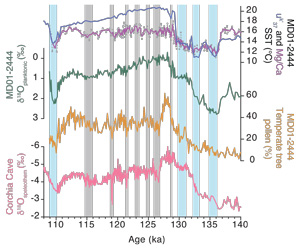- Home
- All News Overview
- Climate Instability In LIG
Climate instability in LIG
Thursday, 11 October, 2018
Considerable ambiguity remains over the extent and nature of millennial/centennial-scale climate instability during the Last Interglacial (LIG; 129-116,000 years ago).
In a new paper released in Nature Communications today, members of the PAGES Working Group on Quaternary Interglacials (QUIGS) find that the Last Interglacial was punctuated by a series of century-scale arid events in southern Europe and cold water-mass expansions in the North Atlantic.
The data also show that the amplitude of the Last Interglacial changes was greater than that of the Holocene. Greenland ice-melt and runoff as a result of excess high-latitude warming may have contributed to the weakening of the Atlantic meridional overturning circulation and to the observed climate changes.
Lead author Chronis Tzedakis said that "although not a strict analogue for future anthropogenically-driven changes, the profile of the Last Interglacial that emerges is one of enhanced century-scale climate instability, with implications for ice-sheet and ocean dynamics."
Read more in the paper "Enhanced climate instability in the North Atlantic and southern Europe during the Last Interglacial", here.
Find out more about the QUIGS working group, and join the mailing list, here.
